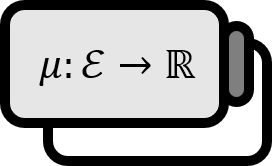Lusin's Theorem
Theorem 1
Let $f : E \to \mathbb{R}$ be a Lebesgue measurable function defined on the measurable set $E \subset \mathbb{R}$. Then, for any given positive number $\epsilon \gt 0$, there exists a measurable set $A \subset \mathbb{R}$ that satisfies the following.
$$ m(A) \le \epsilon \quad \text{ and } \quad g = f|_{E\setminus A} \text{ is continuous.} $$
Here, $m$ is the Lebesgue measure.
Generalization2
If $f$ is a measurable function and it holds that $A \subset \mathbb{R}^{n}$ for $\mu (A) \lt \infty$ and $f(x) = 0 \text{ for } x \in A^{c}$, then, for the given $\epsilon \gt 0$, there exists $g \in$ $C_{c}(\mathbb{R}^{n})$ that satisfies the following.
$$ \sup\limits_{x\in \mathbb{R}^{n}} g(x) \le \sup\limits_{x \in \mathbb{R}^{n}} f(x) \quad \text{ and } \quad \mu \left( \left\{ x \in \mathbb{R}^{n} : f(x) \ne g(x) \right\} \right) \lt \epsilon $$
Explanation
This is known as Lusin’s theorem. In simple terms, there exists a continuous function $g$ that is almost identical to the measurable function $f$. It introduces a proof that does not depend on the Egorov’s theorem and employs topology.
Proof
Since the real space is second-countable, let $\left\{ U_{j} \right\}$ be the countable base of the standard topology for $\mathbb{R}$. And let $U^{j}$ be the open set that satisfies the following.
$$ f^{-1}(U_{j}) \subset U^{j} \quad \text{ and } \quad m(U^{j}\setminus f^{-1}(U_{j})) \lt \dfrac{\epsilon}{2^{j}} $$
Here, $f^{-1}(U_{j})$ is the pre-image of $U_{j}$. And let $A = \bigcup\limits_{j=1}^{\infty} \left( U^{j} \setminus f^{-1}(U_{j}) \right)$. Then, $m(A) \lt \epsilon$ holds.
$$ m(A) \lt \epsilon \sum\limits_{j=1}^{\infty}\dfrac{1}{2^{j}} \lt \epsilon $$
Now, it only remains to show that $g = f|_{E\setminus A}$ is continuous. To prove this, assume the following holds (the actual proof will be postponed).
$$ g^{-1}(U_{j}) = U^{j} \cap \left( E \setminus A \right) \tag{1} $$
Now, if $U \subset \mathbb{R}$ is an open set, since $\left\{ U_{j} \right\}$ is a basis, there exists $M$ satisfying $U = \bigcup_{j \in M} U_{j}$. Then, by $(1)$, the following is true.
$$ g^{-1}(U) = g^{-1} \bigg( \bigcup_{j \in M} U_{j} \bigg) = \bigcup_{j \in M} g^{-1} \left( U_{j} \right) =\bigg( \bigcup_{j \in M} U^{j} \bigg) \cap \left( E \setminus A \right) $$
The union of open sets is an open set, so the right-hand side is an open set from $E\setminus A$. Therefore, $g^{-1}(U)$ is an open set. According to The equivalent conditions of a continuous function, since $g^{-1}(U)$ is an open set for all open sets $U \subset \mathbb{R}$, $g$ is continuous. Now, let’s finish proving $(1)$. $g^{-1}(U_{j}) \subset U^{j} \cap \left( E \setminus A \right)$ is trivial by definition. The inclusion in the opposite direction is derived from the following equation.
$$ \begin{align*} U^{j} \cap (E \setminus A)\ \subset\ U^{j} \cap \left( E \setminus [U^{j} \setminus f^{-1}(U_{j})]\right) &= U^{j} \cap \left( E \cap [U^{j} \setminus f^{-1}(U_{j})]^{c}\right) \\ &= U^{j} \cap E \cap [U^{j} \setminus f^{-1}(U_{j})]^{c} \\ &= U^{j} \cap E \cap [ (U^{j})^{c} \cup f^{-1}(U_{j}) ] \\ &= U^{j} \cap E \cap f^{-1}(U_{j}) \\ &= U^{j} \cap f^{-1}(U_{j}) \\ &= f^{-1}(U_{j}) \\ \end{align*} $$
The first equality is valid by $A \setminus B = A \cap B^{c}$, and the third equality by $(A \setminus B)^{c} = A^{c} \cup B$. By applying $\cap E \setminus A$ to both sides, the following is obtained.
$$ U^{j} \cap (E \setminus A) \subset g^{-1}(U_{j}) $$
■
Feldman, Marcus B. A proof of Lusin’s theorem The American Mathematical Monthly 88.3 (1981): 191-192. ↩︎
Robert A. Adams and John J. F. Foutnier, Sobolev Space (2nd Edition, 2003), p15 ↩︎
